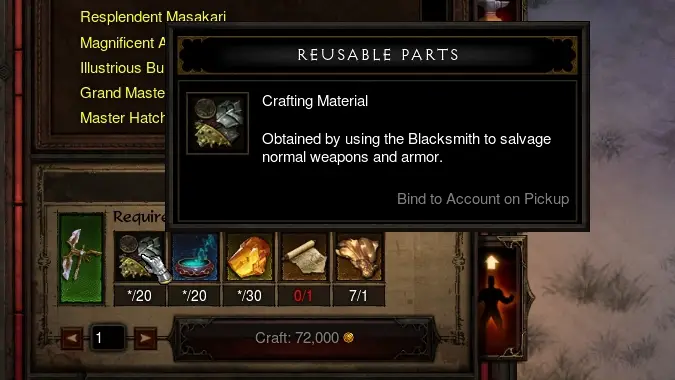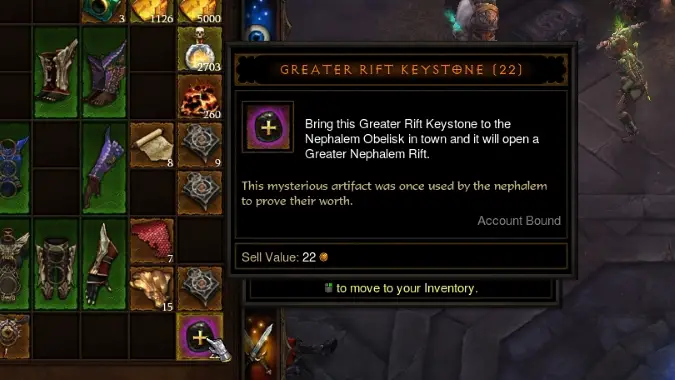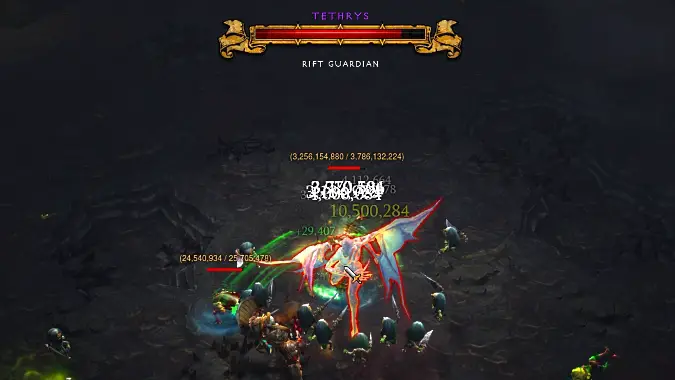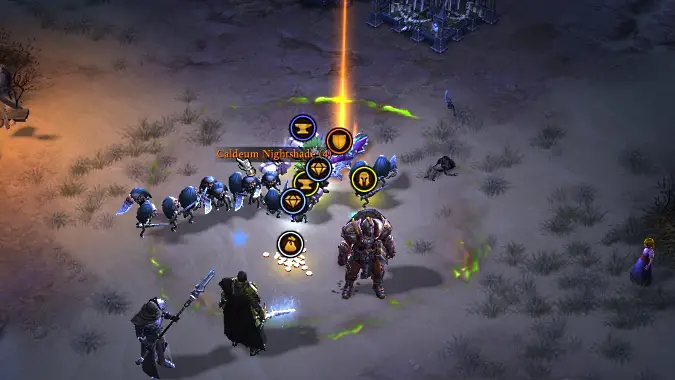Crafting materials for Diablo 3’s patch 2.3.0

One of the big categories of improvement coming in patch 2.3.0 is the revamp to the crafting system in Diablo 3. The Jeweler is self-contained as he uses only gems for the most part to make other gems and rare quality jewelry. The only non-gem materials you’ll need for the Jeweler to craft something are the legendary materials you’ll need for the Hellfire Ring and Amulet. Everything else has been revamped and slimmed down.
Parts, Dust, and Crystals
Just like World of Warcraft’s enchanting profession has dust, essences, shards, and crystals stepping up in quality, Diablo 3 has a set of base materials used for almost everything. Reusable Parts are the white or normal quality material, Arcane Dust is the blue or magic quality material, and Veiled Crystal is the yellow or rare quality material. Each of these materials can stack to 5000 before you need another slot of inventory space. All three materials are used in everything — crafting items at the Blacksmith, enchanting items at the Mystic, and re-rolling items at the Cube.
You can get all three from various drops throughout all gameplay modes. The Odious Collector treasure goblin particularly loves to collect and drop the base three crafting materials as you chase it to its death. Regular and elite monsters will drop materials at chance, but your main sources of the three base materials will be from salvaging items and from bounty caches. All three materials salvage from not only their quality type of item but also from crafted legendaries.
You can convert 100 Parts, Dust, or Crystals into 100 of the other two types by using Kanai’s Cube. You just need to put in 100 of the material you have too much of, one Death’s Breath, and an item of the quality material you want (like a rare item if you want the blue Arcane Dust).

What happens to your old level 60 materials? They convert into the level 70 materials to be used across the whole game whether you have the Reaper of Souls expansion or not. Each vanilla material converts to its similar Reaper of Souls material:
- Common Debris become Reusable Parts
- Exquisite Essences become Arcane Dust
- Iridescent Tears become Veiled Crystals
- Fiery Brimstones become Forgotten Souls
- Demonic Essences become Death’s Breath
Soul and Breath of tinkering with items
Forgotten Soul is the basic legendary crafting material. You can only get it from a drop itself (like from bounty caches or from completing rifts) or from salvaging a dropped legendary. A new change in patch 2.3.0 is that salvaging a crafted legendary will only return Reusable Parts, Arcane Dust, and Veiled Crystals. You must go out and slay things in the world to receive Forgotten Souls.
Although Forgotten Souls are only used for four things in the patch 2.3.0 game, you’ll probably need a couple hundred if you wish to roll a legendary item multiple times at a shot for your best item stats. Even a casual endgame player will use Forgotten Souls often enough to need them:
- 1 Soul for every legendary or set piece you enchant (or reroll one stat on).
- 10 Souls to convert a set item.
- 10 Souls for crafting a Hellfire Amulet, in addition to the four demonic body parts.
- 50 Souls for reforging (or entirely rerolling) a legendary.
Death’s Breath are the special endgame material that you get at maximum level. Typically they drop off elite packs, as well as being dropped rewards from completing bounties and rifts. Death’s Breath are used in the tinkering type of crafting — enchanting and Cube mechanics — where you take an existing item and reroll part of whole of it.

Shards, Keystones, and Machines
These items aren’t crafting materials technically, but you’ll want to collect them in pursuit of better gear and more crafting materials.
Blood Shards are like gold: Technically a dropped item, but it’s a currency rather than an inventory-using item. You’ll find them most often in bounty caches, at the end of rifts, and when chasing the Blood Thief version of a treasure goblin. Blood Shards are capped by how high you can run a Greater Rift, and you can increase the cap by completing higher Greater Rifts in time. Shards are shared across your account on a similar core, so you can use your decked-out Rift runner to help gear up your latest alt project. Kadala, who stands near the rift summoning stone in town, will trade your Blood Shards for random gear in the inventory slot you want.
The way rifts work and level up has been revamped in patch 2.3.0. Currently, you have to do an awkward series of events to get into a Greater Rift appropriate for your gear level:
- Do a set of bounties for a Rift Fragment Keystone.
- Do a regular Nephalem Rift using the Rift Fragment Keystone.
- Complete the Nephalem Rift in time to get a Keystone of Trials.
- Complete a Realm of Trials to sorta maybe guess at your perceived Greater Rift level. This is often way below what you can actually run.
- Complete the Greater Rift that the Realm of Trials gives you, and upgrade your stone at the end.
- Finally do the Greater Rift you intended all along.

In patch 2.3.0, the system is still recognizable but is completely slimmed down to “choose your content.”
- Run a Nephalem Rift to get a Greater Rift Keystone when you complete it quickly enough. Greater Rifts can only be done at level 70.
- With a Greater Rift Keystone in your inventory, select the Greater Rift difficulty level in the rift summoning stone that you wish to run.
- Do the Greater Rift you intended to do.
You may run a Nephalem Rift at any time without needing a keystone — so all those Rift Fragment Keystones just become trash items that vendor for about 500k gold per 100 stack. The Nephalem Rift adjusts to both your character level and your chosen game difficulty, much like the questing and bounty modes do. Old trial keystones and old Greater Rift ranked keystones all convert to the single Greater Rift Keystone that you’ll use in patch 2.3.0.
The Uber system of making a Hellfire Amulet or Hellfire Ring is getting slightly slimmed down as well. Keywardens will keep their name but actually become Machinewardens, dropping the Infernal Machines of the same name as the Keys they used to drop. Any Keys you have in your inventory or stash will convert to the appropriate Machines.
Old level 60 Infernal Machines will not convert to level 70 Machines, but will stay level 60 Infernal Machines. Level 60 Infernal Machines will still create a random portal to a Realm inside the Heretic’s Abode that will drop different legendary materials needed to make the old 3-part Hellfire Rings of Dexterity, Intelligence, Strength, and Vitality. Level 70 Hellfire Rings — 4-part rings — will still require parts from the level 70 Infernal Machines.

New legendary materials
You’ve read about them through Kanai’s Cube and the artisan updates, because you’ll use them when crafting level 70 legendaries at the blacksmith or rerolling items with Kanai’s Cube. Finally, let’s look at the new five legendary crafting materials to use in patch 2.3.0:
- Act I: Khanduran Rune
- Act II: Caldeum Nightshade
- Act III: Arreat War Tapestry
- Act IV: Corrupted Angel Flesh
- Act V: Westmarch Holy Water
They’re listed by Act because you can only gather these materials by completing a specific Act’s set of bounties. With this introduction of new materials, bounties have been revamped. Previously, players would start a game, do the day’s randomly selected two bonus bounties for extra Blood Shards and rift fragments, then exit game and restart game to refresh the bounties.
In patch 2.3.0, only one set of bounties will reward a bonus cache, but the bonus Act will rotate among the available uncompleted Acts as you complete the bonus bounty. For example, if you start the game and the bonus bounty is in Act V, when you complete Act V first, the bonus bounty will move to another uncompleted bounty without you needing to restart the game. This way, you can hit all five Acts’ worth of bounties without ever leaving your game. You can still choose to do a non-bonus Act’s bounties first, but you won’t get the bonus cache and you can’t redo the bounties later in that game for a bonus cache.
The initial bonus bounty does appear to change on game restart as of writing, but this is the PTR and that can change before patch 2.3.0 hits. However, crafting legendaries requires two different Act legendary materials, and the Cube recipes require all five at a time, so it’s probably more beneficial to do whatever Act bonus bounty order you get rather than trying to fish a certain first Act out of restarting games.
Check back next week for a guide to bounties so you can collect these new materials!
Please consider supporting our Patreon!
Join the Discussion
Blizzard Watch is a safe space for all readers. By leaving comments on this site you agree to follow our commenting and community guidelines.
 @_poneria
@_poneria




